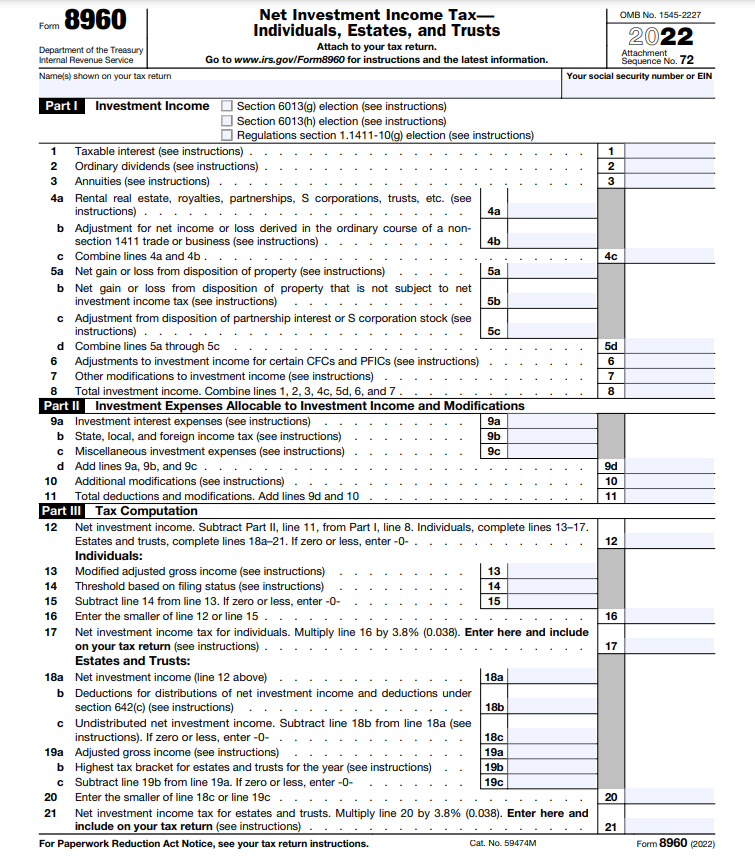Welcome to the intriguing world of Form 8960, a document that holds the key to understanding a facet of taxation that often lurks in the shadows: Net Investment Income Tax (NIIT).
Picture this: you’re cruising through the world of investments, watching your money grow, and enjoying the financial ride. All is well until tax season rolls around, and suddenly, there’s a buzz about Form 8960. What is this form, and why is it making an appearance in your financial narrative?
Imagine Form 8960 as your co-pilot on the financial journey, specifically designed to navigate the intricate waters of net investment income tax (NIIT). It’s not just a form; it’s your backstage pass to understand why a portion of your investment income might be subject to additional taxation.
So, what’s the deal with Form 8960? Well, it’s your ticket to ensuring that when you’re in the investment game you contribute your fair share to the tax pot. This form steps into the limelight when your investment income hits certain thresholds. It’s not about restricting your financial success but rather about maintaining balance and transparency in the world of taxes.
Form 8960 essentially calculates your Net Investment Income (NII), which includes earnings from dividends, capital gains, rental income, and more. When your overall income from these sources exceeds specific limits, Form 8960 taps you on the shoulder and says, “Let’s calculate if there’s a bit more to contribute.”
So buckle up, because you’re about to demystify the tax code and empower you with the knowledge to navigate the financial seas like a seasoned captain.
- Understand Form 8960: Net Investment Income Tax
- Who Needs to File Form 8960?
- What Constitutes Net Investment Income?
- How to File Form 8960
- Common Challenges and Pitfalls
- Planning Strategies to Minimize Net Investment Income Tax
Recap
1. Understand Form 8960: Net Investment Income Tax

Form 8960, or the Net Investment Income Tax (NIIT), is a tax form from the IRS linked to the Affordable Care Act. It figures out the net investment income tax, a 3.8% tax targeting specific investment income. If you earn above set thresholds, this tax applies to individuals, estates, and trusts.
Why? The aim is to support Medicare by having wealthier individuals contribute part of their investment income towards healthcare expenses. So, grasping Form 8960 matters if your income reaches those levels. It’s not just about reporting income; it’s a way the government ensures that if you earn more, you help fund vital health services. In short, it’s a tool for financial fairness, making sure you play a part in supporting healthcare costs through your investment income. Understanding and properly handling Form 8960 becomes crucial for you if you fall under its scope to navigate these tax responsibilities effectively.
2. Who Needs to File Form 8960?
If you’re a person, or if you’re managing an estate or trust, you need to fill out Form 8960 based on some rules. For individuals, it depends on your modified adjusted gross income (MAGI). If you’re single and your MAGI goes over $200,000, or if you’re married and filing jointly with a MAGI over $250,000 in the tax year 2023, you need to use Form 8960.
Now, if the estates and trusts you are involved in have undistributed net investment income and the adjusted gross income (AGI) is higher than a certain threshold that marks the beginning of the highest tax bracket for estates and trusts, then the estates and trusts need to file Form 8960. So, essentially, it’s a tax form you may need to deal with if you, or the estate or trust you’re involved with, meet these specific income criteria.
>>>PRO TIPS: Federal Tax Credit for Residential Solar Energy
3. What Constitutes Net Investment Income?
Net Investment Income includes various types of income that fall under three main categories:
Interest, Dividends, and Capital Gains
Picture it as a trio: money from interest on loans, dividends from investments, and profits from selling assets. It’s like your financial portfolio’s paycheck.
Rental and Royalty Income
Think of this as your property side hustle—the money you make from renting out spaces or receiving royalties. It’s like your real estate and creative endeavors are paying off.
Passive Income
Imagine money flowing in from ventures where you’re not actively involved, like investments or businesses you don’t manage day-to-day. It’s the income that rolls in without demanding your constant attention, a bit like a financial autopilot.
So, net investment income is essentially your money team, with interest, rentals, and passive earnings playing key positions. Note that not all types of income are subject to the Net Investment Income Tax. Wages, unemployment compensation, operating income from non-passive businesses, Social Security benefits, and distributions from retirement plans are generally not considered net investment income.
4. How to File Form 8960
When tackling Form 8960, imagine it as a financial puzzle you’re solving. Your goal is to report all your investment income accurately to the IRS. The form is like a structured questionnaire, asking you about different slices of your financial life. Picture it having sections for various income sources and deductions – a bit like separating different types of money matters.
To fill it out, gather details on your investment income, and then consider certain deductions that can lower the amount you’re taxed on. These deductions might include things like interest expenses from investments, state and local income taxes, and specific costs tied to rental and royalty income. It’s crucial to grasp the ins and outs of these deductions, as it’s your tool to make sure you’re not paying more in taxes than necessary. So, Form 8960 is your roadmap to navigate the taxation landscape for your investments wisely.
>>>GET SMARTER: Form 8917: What It Is, How to File It
5. Common Challenges and Pitfalls
One challenge you may face when dealing with Form 8960 is the complexity of investment income. Different types of investments may have different tax implications, and navigating the rules and regulations can be daunting. So, seek the guidance of a tax professional, especially if you’ve got diverse investment portfolios.
Another potential pitfall is failing to account for income that is subject to the Net Investment Income Tax. You may not realize that certain types of income are included, leading to inadvertent non-compliance. Proper record-keeping and a thorough understanding of the tax code are essential to avoid such pitfalls.
6. Planning Strategies to Minimize Net Investment Income Tax
If you’re worried about facing the net investment income tax, there are practical strategies to ease its impact. These may include:
Tax-Loss Harvesting
Offset capital gains with capital losses to reduce overall net investment income.
Consider Tax-Advantaged Investments
Some investments, such as municipal bonds, may generate income that is exempt from the Net Investment Income Tax.
Diversification
Diversifying investment portfolios can help you spread income across different types of assets, potentially lowering the overall impact of the Net Investment Income Tax.
Recap
In conclusion, Form 8960 plays a crucial role in calculating and reporting the net investment income tax. Understanding who needs to file, what constitutes net investment income, and how to complete the form is essential for those who may be subject to this additional tax.
Remember, this form isn’t a foe—it’s a tool empowering you to navigate the tax landscape with clarity. Understanding how your investment income aligns with tax thresholds is like having a compass for your financial journey.
In the vast sea of financial transactions, Form 8960 emerges as a guide, ensuring fairness and transparency. So, embrace it as a partner rather than a puzzle. As you venture into the world of investments, armed with the knowledge of Form 8960, you’re better equipped to make informed decisions.
Stay vigilant, keep your financial records in order, and stay informed about any changes in tax regulations. With these tools in hand, you’re not just navigating but also conquering the tax seas. Your financial voyage is unique, and Form 8960 is here to ensure it remains smooth and steady. Happy sailing!
This post is to be used for informational purposes only and does not constitute legal, business, or tax advice. Each person should consult his or her own attorney, business advisor, or tax advisor with respect to matters referenced in this post. . For comprehensive tax, legal or financial advice, always contact a qualified professional in your area. S’witty Kiwi assumes no liability for actions taken in reliance upon the information contained herein.








No Comment! Be the first one.